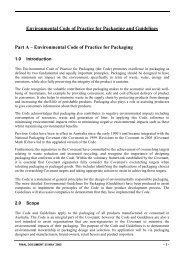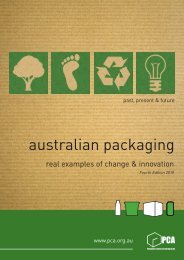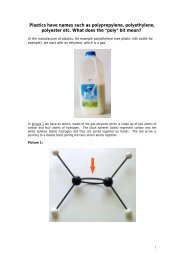Food labelling guide - the Packaging Council of Australia
Food labelling guide - the Packaging Council of Australia
Food labelling guide - the Packaging Council of Australia
Create successful ePaper yourself
Turn your PDF publications into a flip-book with our unique Google optimized e-Paper software.
A component or ingredient is considered to be characterising and <strong>the</strong>refore must be declared<br />
on <strong>the</strong> food label as a proportion when <strong>the</strong> component or ingredient is:<br />
• mentioned in <strong>the</strong> name <strong>of</strong> a food (e.g. strawberry may be <strong>the</strong> characterising ingredient in<br />
strawberry yoghurt)<br />
• customarily associated with <strong>the</strong> name <strong>of</strong> <strong>the</strong> food by <strong>the</strong> consumer (e.g. fish may be <strong>the</strong><br />
characterising ingredient in fisherman’s pie)<br />
• emphasised on <strong>the</strong> label <strong>of</strong> a food in words, pictures or graphics (e.g. fruit juice may be<br />
<strong>the</strong> characterising ingredient in real fruit juice sweets).<br />
The code’s requirement that characterising ingredients and components be declared on food<br />
labels enables consumers to identify how much <strong>of</strong> a characterising ingredient or component is<br />
present in <strong>the</strong> product. In turn, this assists consumers to compare one product with ano<strong>the</strong>r<br />
and to make informed choices about <strong>the</strong> foods <strong>the</strong>y purchase.<br />
All food standards within <strong>the</strong> code are enforceable under <strong>the</strong> food Acts in each state and<br />
territory <strong>of</strong> <strong>Australia</strong>, and in New Zealand. It is an <strong>of</strong>fence in both countries to supply food<br />
that does not comply with relevant food standards. Agencies responsible for enforcing and<br />
interpreting <strong>the</strong> code within <strong>Australia</strong> are state and territory health departments and, where <strong>the</strong><br />
code relates to imports, <strong>the</strong> <strong>Australia</strong>n Quarantine and Inspection Service. In New Zealand, <strong>the</strong><br />
New Zealand Government is responsible for this role. Because food standards are given legal<br />
effect by state, territory and New Zealand laws, it is important that <strong>the</strong> code’s requirements<br />
are considered in conjunction with <strong>the</strong> relevant local food legislation, including <strong>the</strong> Trade<br />
Practices Act.<br />
6 <strong>Food</strong> <strong>labelling</strong> <strong>guide</strong>













